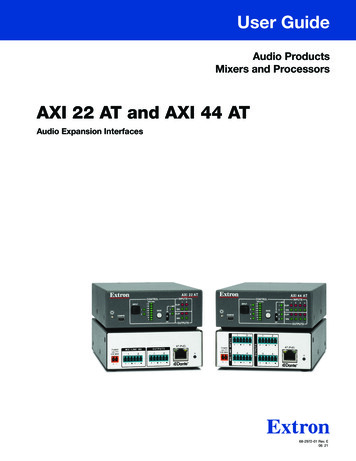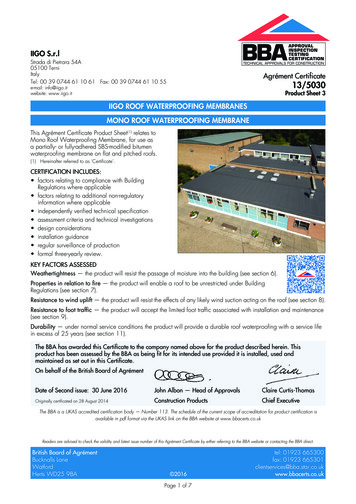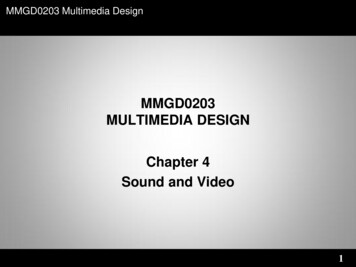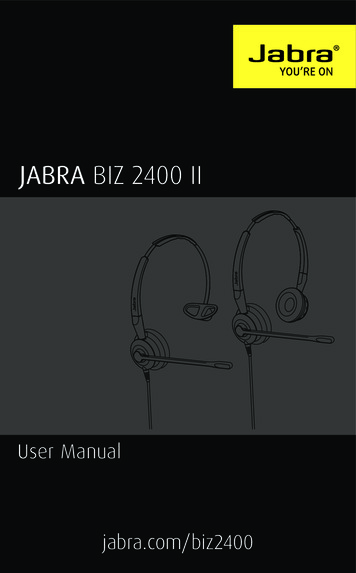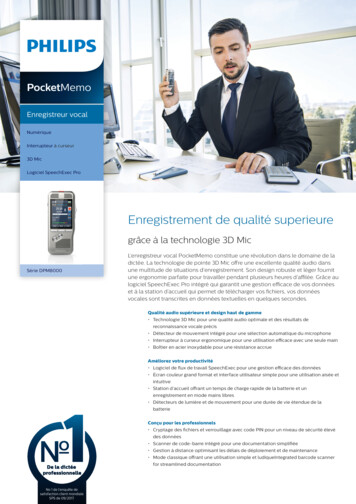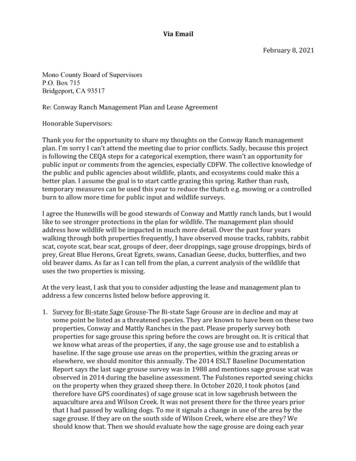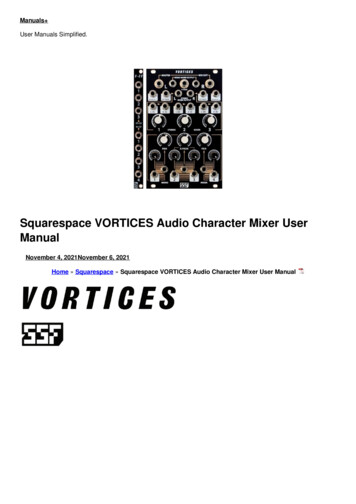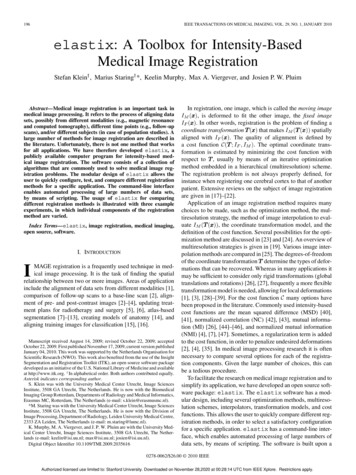
Transcription
196IEEE TRANSACTIONS ON MEDICAL IMAGING, VOL. 29, NO. 1, JANUARY 2010elastix: A Toolbox for Intensity-BasedMedical Image RegistrationStefan Kleiny , Marius Staringy *, Keelin Murphy, Max A. Viergever, and Josien P. W. PluimAbstract—Medical image registration is an important task inmedical image processing. It refers to the process of aligning datasets, possibly from different modalities (e.g., magnetic resonanceand computed tomography), different time points (e.g., follow-upscans), and/or different subjects (in case of population studies). Alarge number of methods for image registration are described inthe literature. Unfortunately, there is not one method that worksfor all applications. We have therefore developed elastix, apublicly available computer program for intensity-based medical image registration. The software consists of a collection ofalgorithms that are commonly used to solve medical image registration problems. The modular design of elastix allows theuser to quickly configure, test, and compare different registrationmethods for a specific application. The command-line interfaceenables automated processing of large numbers of data sets,by means of scripting. The usage of elastix for comparingdifferent registration methods is illustrated with three exampleexperiments, in which individual components of the registrationmethod are varied.Index Terms—elastix, image registration, medical imaging,open source, software.I. INTRODUCTIONIMAGE registration is a frequently used technique in medical image processing. It is the task of finding the spatialrelationship between two or more images. Areas of applicationinclude the alignment of data sets from different modalities [1],comparison of follow-up scans to a base-line scan [2], alignment of pre- and post-contrast images [2]–[4], updating treatment plans for radiotherapy and surgery [5], [6], atlas-basedsegmentation [7]–[13], creating models of anatomy [14], andaligning training images for classification [15], [16].Manuscript received August 14, 2009; revised October 22, 2009; acceptedOctober 22, 2009. First published November 17, 2009; current version publishedJanuary 04, 2010. This work was supported by the Netherlands Organisation forScientific Research (NWO). This work also benefited from the use of the InsightSegmentation and Registration Toolkit (ITK), an open source software packagedeveloped as an initiative of the U.S. National Library of Medicine and availableat http://www.itk.org. In alphabetical order. Both authors contributed equally.Asterisk indicates corresponding author.S. Klein was with the University Medical Center Utrecht, Image SciencesInstitute, 3508 GA Utrecht, The Netherlands. He is now with the BiomedicalImaging Group Rotterdam, Departments of Radiology and Medical Informatics,Erasmus MC, Rotterdam, The Netherlands (e-mail: s.klein@erasmusmc.nl).*M. Staring was with the University Medical Center Utrecht, Image SciencesInstitute, 3508 GA Utrecht, The Netherlands. He is now with the Division ofImage Processing, Department of Radiology, Leiden University Medical Centre,2333 ZA Leiden, The Netherlands (e-mail: m.staring@lumc.nl).K. Murphy, M. A. Viergever, and J. P. W. Pluim are with the University Medical Center Utrecht, Image Sciences Institute, 3508 GA Utrecht, The Netherlands (e-mail: keelin@isi.uu.nl; max@isi.uu.nl; josien@isi.uu.nl).Digital Object Identifier 10.1109/TMI.2009.2035616In registration, one image, which is called the moving image, is deformed to fit the other image, the fixed image. In other words, registration is the problem of finding athat makesspatiallycoordinate transformation. The quality of alignment is defined byaligned with. The optimal coordinate transa cost functionformation is estimated by minimizing the cost function withrespect to , usually by means of an iterative optimizationmethod embedded in a hierarchical (multiresolution) scheme.The registration problem is not always properly defined, forinstance when registering one cerebral cortex to that of anotherpatient. Extensive reviews on the subject of image registrationare given in [17]–[22].Application of an image registration method requires manychoices to be made, such as the optimization method, the multiresolution strategy, the method of image interpolation to eval, the coordinate transformation model, and theuatedefinition of the cost function. Several possibilities for the optimization method are discussed in [23] and [24]. An overview ofmultiresolution strategies is given in [19]. Various image interpolation methods are compared in [25]. The degrees-of-freedomof the coordinate transformation determine the types of deformations that can be recovered. Whereas in many applications itmay be sufficient to consider only rigid transformations (globaltranslations and rotations) [26], [27], frequently a more flexibletransformation model is needed, allowing for local deformations[1], [3], [28]–[39]. For the cost function many options havebeen proposed in the literature. Commonly used intensity-basedcost functions are the mean squared difference (MSD) [40],[41], normalized correlation (NC) [42], [43], mutual information (MI) [26], [44]–[46], and normalized mutual information(NMI) [4], [7], [47]. Sometimes, a regularization term is addedto the cost function, in order to penalize undesired deformations[2], [4], [35]. In medical image processing research it is oftennecessary to compare several options for each of the registration components. Given the large number of choices, this canbe a tedious procedure.To facilitate the research on medical image registration and tosimplify its application, we have developed an open source software package: elastix. The elastix software has a modular design, including several optimization methods, multiresolution schemes, interpolators, transformation models, and costfunctions. This allows the user to quickly compare different registration methods, in order to select a satisfactory configurationfor a specific application. elastix has a command-line interface, which enables automated processing of large numbers ofdata sets, by means of scripting. The software is built upon a0278-0062/ 26.00 2010 IEEEAuthorized licensed use limited to: Stanford University. Downloaded on November 28,2020 at 00:28:14 UTC from IEEE Xplore. Restrictions apply.
KLEIN et al.: elastix: A TOOLBOX FOR INTENSITY-BASED MEDICAL IMAGE REGISTRATION197Fig. 1. Basic registration components. The scheme is an extended version of the scheme introduced in [48]. Each component is accompanied by a section numberwhere more information can be found. Dashed box around the complete scheme represents the various hierarchical strategies, which can affect all components;see Section II-C-6.widely used open source library for medical image processing,the Insight Toolkit (ITK) [48].In Section II, the general registration framework of elastixis discussed, key features of the software are presented, andan overview of the available registration components is given.In Section III, three examples of applications that can be handled with the software are given. In these experiments, the influence of three important registration components is demonstrated. Section IV presents several guidelines for the use ofelastix. The paper ends with a discussion (Section V) andthe conclusions (Section VI).II. IMAGE REGISTRATION WITH ELASTIXA. Registration FrameworkMathematically, the registration problem is formulated as anoptimization problem in which the cost function is minimizedwith respect to . The elastix software is based on a parametric approach, meaning that the number of possible transformations is limited by introducing a parametrization of the transformation. The optimization problem reads(1)where the subscript indicates that the transform has been parameterized. The vector contains the transformation parameters. The reader is referred to [21] and [35] for an overviewon nonparametric methods. The minimization problem (1) issolved with an iterative optimization method, usually in a multiresolution setting. A schematic overview of the basic registration components and their relations is given in Fig. 1, which isa slightly extended version of the scheme introduced in [48]. Adetailed explanation of the various components is given in Section II-C.B. Software CharacteristicsThe elastix software is structured according to the blockscheme of Fig. 1. For each component (transform, cost function,etc.) several choices are available. The user can configure a registration algorithm by specifying the names of the desired components in a parameter text file. Additional settings that somecomponents may require can also be entered in this parameterfile. Fixed and moving image file names are supplied as command-line arguments, so that multiple image pairs can be registered using the same parameter settings. An example of usage isgiven in the Appendix. Both 2-D and 3-D images are supported.All output of the registration, such as the deformed movingand intermediate progress information, isimagesaved to disk. It is often necessary to apply the resulting transto data sets other than the moving image. For exformationample, in atlas-based segmentation methods [7], [8] the transformation is applied to a segmentation (label image) of the movingimage. To that end, elastix outputs a text file that describesthe transformation . This text file can subsequently be passedto an accompanying program, called transformix, togetherwith the image to be deformed. This program can also be usedto evaluate the transformation at user-defined points, or to generate the deformation field.A large part of the elastix code is based on the ITK [48].The use of the ITK implies that the low-level functionality(image classes, memory allocation, etc.) is thoroughly tested.Naturally, all image formats supported by the ITK are supportedby elastix as well. The C source code can be compiledon multiple operating systems (Windows XP, Linux, Mac OSX), using various compilers (MS Visual Studio up to version2008, GCC up to version 4.3), and supports both 32 and 64bit systems. In addition to the existing ITK image registrationclasses, elastix implements new functionality. The mostimportant enhancements are listed in Table I.The elastix source code consists roughly of two layers,both written in C : A) ITK-style classes that implement imageregistration functionality, and B) elastix wrappers that takecare of reading and setting parameters, instantiating and connecting components, saving (intermediate) results, and similar“administrative” tasks. The modular design enables adding newcomponents, without changing the elastix core. Adding anew component starts by creating the layer A class, which canAuthorized licensed use limited to: Stanford University. Downloaded on November 28,2020 at 00:28:14 UTC from IEEE Xplore. Restrictions apply.
198IEEE TRANSACTIONS ON MEDICAL IMAGING, VOL. 29, NO. 1, JANUARY 2010TABLE ITHE MOST IMPORTANT ENHANCEMENTS AND ADDITIONS IN elastix,COMPARED TO THE ITKbe compiled and tested independent of layer B. Subsequently, asmall layer B wrapper needs to be written, which connects thelayer A class to the other parts of elastix.Executables and source code are publicly available onlineunder the BSD license, which allows free academic and commercial use and permits modification of the source code. Amanual for elastix and an example of usage can also bedownloaded. The manual includes an example parameter file,describes in detail the various options that can be specified, andprovides recommendations for image registration. The manualalso contains information about elastix’s more advancedregistration possibilities, not treated in this paper, such as theregistration of multispectral data. In addition, we created a“parameter file database,” which is a collection of parameterfiles that proved successful, together with a short descriptionof the clinical application for which they were used. Theparameter file database can be found through the website andelastix-users are encouraged to upload their own settings.A default parameter file can also be found here.C. Registration ComponentsIn the following subsections, more information is given abouteach component of the block scheme in Fig. 1.1) Cost Function: The cost function measures the similarity between the fixed image and the transformed movingimage. An example is the MSD(2)wheredenotes the fixed image domain, and the numberof voxels sampled from the fixed image domain. The sampler,which is responsible for selecting the samples , is discussed inmore detail in Section i.uu.nl/wiki.phpThe following metrics are currently supported by elastix:mean square difference (MSD), normalized correlation (NC),mutual information (MI), normalized MI (NMI), -MI [49],[50], and the -statistic [51]. MSD is only suited for two imageswith equal intensities, i.e., for images from the same modality.NC is less strict, it assumes an affine relation between the intensity values of the fixed and moving image. MI, NMI, and -MIassume only a statistical relation between the intensities of theimages. They are therefore suited not only for monomodal, butalso for multimodal image pairs. The -statistic can be used forregistering binary images. It measures the overlap of objects inthe images. For each of the metrics above, a localized versioncan be constructed, as explained in [8], by selecting the appropriate sampler. This is described in Section II-C-4.Parameters such as the number of bins of the joint histogram,needed for MI and NMI, can be set in the aforementioned parameter file.When a nonrigid transformation model is used, a regularization term that penalizes undesired deformations can be addedto the cost function. An example is the incompressibility constraint described by [4], which penalizes compression and expansion of structures. Other examples of regularization termsare the bending energy of a thin plate [3] and the rigidity penaltyterm [2]. elastix supports these constraints.2) Transformation: The parametrization of the coordinatedetermines the degrees-of-freedom of thetransformationdeformation. An example is the affine transformation model,which allows for translation, rotation, scaling and skew of theimages(3)where is a matrix and represents the translation vector. Theand theparameter vector is formed by the matrix elementstranslation vector. In 2-D, this gives a vector of dimension 6:. In 3-D, consists of 9 matrixelements and 3 translational components.The following transformation models are currently supportedby elastix, with the number of degrees-of-freedom (dimension of ) between brackets: translation (3), rigid (translationand rotation, 6), similarity (rigid plus isotropic scaling, 7),affine (12), and nonrigid (varying size of ). In the literature,several parametric nonrigid transformation models have beenproposed [3], [28], [30], [32], [36], [37], each having its ownadvantages and disadvantages. In elastix a B-spline representation [3] has been implemented and several physics-basedspline models [30], [52], such as the thin-plate spline and theelastic body spline. The B-spline transformation is modelledas a weighted sum of B-spline basis functions, placed on auniform control point grid. The B-spline basis functions havelocal support [53], which is beneficial for fast computation. Theflexibility of the deformation is defined by the resolution of thecontrol point grid, which has to be supplied by the user via theparameter file. Section III-A demonstrates the effect of usingdifferent control point resolutions for an example application.The physics-based spline transformation allows the user toplace control points at arbitrary positions, not necessarily ona uniform grid. Lastly, elastix includes a transformationAuthorized licensed use limited to: Stanford University. Downloaded on November 28,2020 at 00:28:14 UTC from IEEE Xplore. Restrictions apply.
KLEIN et al.: elastix: A TOOLBOX FOR INTENSITY-BASED MEDICAL IMAGE REGISTRATIONthat is modelled as a weighted combination of user-specified. The weightsformtransformations:may forthe parameter vector . The subtransformsexample follow from a statistical deformation model, obtainedby principal component analysis [54].The aforementioned regularization term in the cost functionis often expressed in terms of first- and second-order spatialand[2]–[4].derivatives of the transformationThe modular framework of the ITK was extended to supportthese derivatives, together with their derivatives to requiredfor gradient-based optimization routines.Frequently, nonrigid registration must be preceded by a rigidor affine registration, in order to achieve a rough initial alignment. elastix supports the concatenation of any sequenceof transforms. The user may also supply an initial transformation, determined in advance by the user. It can be expressed asone of the available transformations, or as a dense deformationfield vector image. The transformation may for example be derived (in external software) from a set of manually clicked corresponding points.3) Optimization: To solve (1), an iterative optimization procedure is employed. In every iteration , the current transforare updated by taking a step in the searchmation parametersdirection(4)a scalar that determines the step size. A wide rangewithof optimization methods can be formulated in this way, eachhaving different definitions of and [24]. A common choicefor the search direction is the derivative of the cost functionevaluated at the current position . In this case, (4)reduces to a gradient descent method.elastix includes all optimization methods described in[24]: gradient descent, quasi-Newton, nonlinear conjugategradient (several variants), evolution strategy, and a numberof stochastic gradient descent methods (Kiefer–Wolfowitz,Robbins–Monro, and simultaneous perturbation). An exhaustive search routine is also included, which is mainly useful forexamining the cost function, as demonstrated in Section III-B.The experimental results in [24] indicate that a stochasticgradient descent method (Robbins–Monro) is a good choice formany applications. It reduces the computation time per iteration by using only a small subset of the fixed image’s voxelsfor computing the cost function derivative. In each iteration,new samples must be selected randomly. This can be realizedin elastix by selecting an appropriate sampler, which isexplained in the next subsection. A recent extension of theRobbins–Monro algorithm, called adaptive stochastic gradientdescent [55], which aims at simplified parameter selection andfurther acceleration, is also included in elastix.4) Sampling Strategies: To compute the cost function (and) a set of samplesneeds to be seits derivativelected, as in (2). The sampler component in Fig. 1 is responsiblefor this. The most straightforward strategy is to use all voxelsfrom the fixed image, which has as an obvious downside that itis time-consuming for large images. A common approach is touse a subset of voxels, selected on a uniform grid, or sampled199 80Fig. 2. Two multiresolution strategies using a Gaussian pyramid ( : , 4.0,2.0 voxels). The top row shows multiresolution with downsampling, the bottomrow without. Note that in the top row the number of voxels in each dimension ishalved every resolution, but the voxel size is doubled, so physically the imagesare of the same size. (a) res. 0. (b) res. 1. (c) res. 2. (d) original. (e) res. 0. (f)res. 1. (g) res. 2. (h) original.randomly. Another strategy is to pick only those points that arelocated on striking image features, such as edges [56].elastix currently supports the use of all voxels, a subset ofvoxels selected on a uniform grid, random sampling of voxels,and random sampling off the voxel grid (at nonvoxel locations).Random sampling off the grid has been shown to improve thesmoothness of the cost function [57], [58]. In Section III-B, wedemonstrate this effect by comparing several sampling schemeson an example application. For all sampling strategies discussedabove, the user may optionally supply a mask image, indicatingregions of interest. In this way, one can force the sampler to pickonly points near edges in the image, for example.With random sampling, the elastix user can enforce theselection of new samples in every iteration of the optimization process. In this way, the stochastic optimization methodsdescribed in [24] can be realized. The localized mutual information strategy, presented in [8], can be implemented by letting thesampler pick points in a small neighborhood, instead of from the. A new neighborhood is randomly selected inentire domainevery iteration of the optimization procedure.5) Interpolation: For computation of the cost function, theis evaluated at nonvoxel positions, for whichvalueintensity interpolation is needed. Several methods for interpolation exist, varying in quality and speed, including nearestth-order B-spline interpolation [53],neighbor, linear and[59]. elastix supports all interpolators mentioned above.no interpolation is required with mostFor the fixed imagesampling strategies, since the image is sampled at voxel locations. For sampling off the voxel grid, however, an additionalinterpolator is needed, not depicted in Fig. 1.6) Hierarchical Strategies: Hierarchical (multiresolution)strategies are an important aspect of image registration. For anextensive overview, the reader is referred to [19]. elastiximplements several hierarchical strategies: The pyramid components in the block scheme of Fig. 1represent the multiresolution schemes for the image data.Two types of image pyramids are available in elastix:Gaussian pyramids with and without downsampling. Fig. 2illustrates the difference.Authorized licensed use limited to: Stanford University. Downloaded on November 28,2020 at 00:28:14 UTC from IEEE Xplore. Restrictions apply.
200IEEE TRANSACTIONS ON MEDICAL IMAGING, VOL. 29, NO. 1, JANUARY 2010 The second important multiresolution strategy, not apparent from Fig. 1, is the gradual increase of transformation model complexity. During nonrigid registration, ahierarchical effect can be realized by starting with a coarseB-spline control point resolution and gradually refining thegrid in subsequent resolutions [53], thereby introducingthe capability to recover more fine-scale deformations. Inelastix, the B-spline control point grid can be refinedusing any upsampling factor, possibly different for eachdimension. More generally, many parameter settings can be subjectedto a hierarchical strategy in elastix. For example, thenumber of joint histogram bins that is used for computingMI and NMI could be gradually increased, as was suggested in [45].The third point above is represented by the dashed boxaround the entire scheme. The first two strategies, regardingimage pyramid level and transformation model complexity, aredepicted explicitly in Fig. 1 by the dashed arrows originatingfrom the outer box. In Section III-C several multiresolutionstrategies are compared for the nonrigid registration of computed tomography (CT) chest scans.III. EXPERIMENTS AND RESULTSIn this section, some applications of elastix are described, to illustrate its convenience for configuring, testing,and comparing different registration methods. To illustratethe wide usability of elastix, the image data was chosenfrom different modalities, at different acquisition times, andfrom different subjects. Three key components of registrationwere studied: the transformation model in Section III-A, thesampling technique in Section III-B, and the multiresolutionstrategy in Section III-C. The experiments demonstrate theimpact these components can have on the registration results,and therefore stress the importance of a proper configurationfor the application at hand.The elastix settings that were used in the following subsections have been made available via the parameter file database, see Section II-B. Exact registration settings for each experiment can be inspected there, and the parameter files can bedownloaded for use in other applications.A. Transformation ModelsThe effect of the type of transformation was investigated bycomparing the registration performance of several transformation models.To this end, a set of 50 clinical MR scans of the prostatewas used, all originating from different patients. The scanswere made by the Department of Radiotherapy of the University Medical Center Utrecht, as part of prostate cancertreatment planning. They were acquired on a Philips 3Tscanner (Gyroscan NT Intera, Philips Medical Systems, Best,The Netherlands) using a balanced steady-state free precessionsequence with fat suppression. The scans had dimensions ofvoxels of sizemm.Fifty interpatient registrations were performed by registeringeach MR scan with its predecessor in the 50-scan series. Interpatient registration of these scans is needed for atlas-basedFig. 3. Effect of the transformation model on the accuracy of registration, measured by the prostate overlap. Abbreviation BS-hspi refers to a B-spline transformation with control point spacing sp, in millimeters.segmentation of the prostate [8]. The registration problem ischallenging, since the anatomical variability between subjectsis large. Also, the data suffer from several artefacts, as shownin [8]. For our experiments we used the same settings as in [8],with localized MI as a cost function (see Section II-C-4), anda four-level Gaussian image pyramid with downsampling. Thefollowing transformation models were compared: translation,rigid, affine, and B-spline with different control point spacings:64, 32, 16, 8, and 4 mm. The result of the registration with translations was only used as an initialization for all other registrations. For the B-spline registrations, the control point grid wassubjected to a multiresolution scheme: registration starts with acoarse control point resolution; with less smooth versions of theimages, the control point resolution is increased accordingly.For all images a manual segmentation of the prostate wasavailable, made by an experienced radiation oncologist. Afterwas apregistration with elastix, the transformationplied to the prostate segmentation of the moving image, usingtransformix. The overlap with the segmentation of thefixed image was computed, using the Dice similarity coefficient(DSC) [60]:(5)whereand represent the two segmentations, anddenotes the number of voxels within the segmentation. A DSC of1 indicates a perfect alignment of the segmentation boundary.A value of 0 means that the prostates had no overlap at all afterregistration.The results are presented in Fig. 3. For each transformationmodel, the DSC values of the 50 MR scans were summarisedby a box-and-whiskers plot. A paired, two-sided Wilcoxon testAuthorized licensed use limited to: Stanford University. Downloaded on November 28,2020 at 00:28:14 UTC from IEEE Xplore. Restrictions apply.
KLEIN et al.: elastix: A TOOLBOX FOR INTENSITY-BASED MEDICAL IMAGE REGISTRATION201Fig. 4. Effect of different sampling strategies on the smoothness of the cost function; a) translation in the z direction; b) translation in the z direction afterdownsampling the MR image in the z direction; c) translation in the x direction.was used to assess the median differences between adjacentcolumns. A star on top of a column indicates a significant differwith respect to the previous column. The graphenceclearly shows that a nonrigid registration was essential in thisapplication. The best results were obtained using a B-spline control point spacing of 8 mm. Refining the control point spacing to4 mm yielded worse results due to a lack of regularization. Thetransformation had too many degrees-of-freedom in this case,which caused unrealistic deformations. The outlier with a verylow DSC value represents a case where the translation registration failed completely. The subsequent nonrigid registration wasnot able to recover from this error. With the optimal setting of8 mm, the computation time was around 15 min per registrationon a single processor Pentium 2.8-GHz personal computer.B. Sampling StrategiesThe grid effect is a well-known issue in image registration.It refers to the problem that the cost function contains irregularities at locations representing grid-aligning transformations,which can impede the registration process. It has often beenstudied in the context of interpolation artefacts [25]. In this section it is demonstrated that the sampling mechanism can solvethis issue, by taking samples off the voxel grid, as suggested in[57], [58].Brain images were taken from the “retrospective image registration evaluation” (RIRE) project [27], which has ground truthcorrespondences for the 8 corner points of the images. We investigated the registration of a T1-weighted MR image (movingimage) to a PET image (both of patient 001). The PET imagevoxels of sizehad a dimension ofmm. The MR image had a dimension ofvoxels of sizemm.The cost function (MI) was analysed using an exhaustivesearch in a single translation direction, with a step size of.0.1 mm. Linear interpolation was used to computeDifferent sampling strategies were employed for computing thecost function: all voxels, random sampling on the voxel grid,and random sampling off the voxel grid.is plotted asIn Fig. 4(a) the cost functiona function of the translation , the direction with the largestvoxel spacing. The two samplers that take samples on the voxelgrid have a very irregular cost function. The irregularities showa pattern, related to the voxel sizes of the images in the direction (8 mm for PET, 4 mm for MR). Every 8 mm a slice of thePET image maps outside the MR image. This causes the largemm and 20 mm for example. Every 4discontinuities atmm, the cost function exhibits a small local maximum, causedby the aligning voxel grids of the images. The random sam
classes, elastix implements new functionality. The most important enhancements are listed in Table I. The elastix source code consists roughly of two layers, bothwritteninC :A)ITK-styleclassesthatimplementimage registration functionality, and B) elastix wrappers that take care of reading and setting parameters, instantiating and con-
